Abstract
The effect of beta adrenergic stimulation on renal-diluting capacity was examined in the dog. Beta adrenergic stimulation with intravenous isoproterenol significantly increased urinary osmolality (UOsm) and decreased free water clearance (CH2O), and these effects were rapidly reversible with cessation of the infusion. This antidiuretic effect of systemic beta adrenergic stimulation was comparable in innervated and denervated kidneys and was not associated with alterations in glomerular filtration rate or renal vascular resistance. Renal perfusion pressure was maintained constant in all of the experiments. The same dose of isoproterenol, which produced the antidiuretic effect and markedly stimulated cardiac beta adrenergic receptors when infused intravenously, was not found either to increase UOsm or to decrease CH2O when infused directly into the renal artery. Removal of the source of production and release of antidiuretic hormone (ADH) was, however, found to abolish the effect of intravenous isoproterenol on UOsm. A small effect on CH2O persisted and appeared to be related to an increase in arterial hematocrit. Thus, the results of the study exclude a major role of alterations in renal hemodynamics and renal innervation in the antidiuretic response to beta adrenergic stimulation with isoproterenol. They also provide no support for the hypothesis that beta adrenergic stimulation may directly alter the water permeability of the renal tubular epithelium. Rather the results suggest that the primary mechanism of the antidiuretic effect of beta adrenergic stimulation involves the integrity of the hypothalamoneurohypophyial system and the release of ADH.
Full text
PDF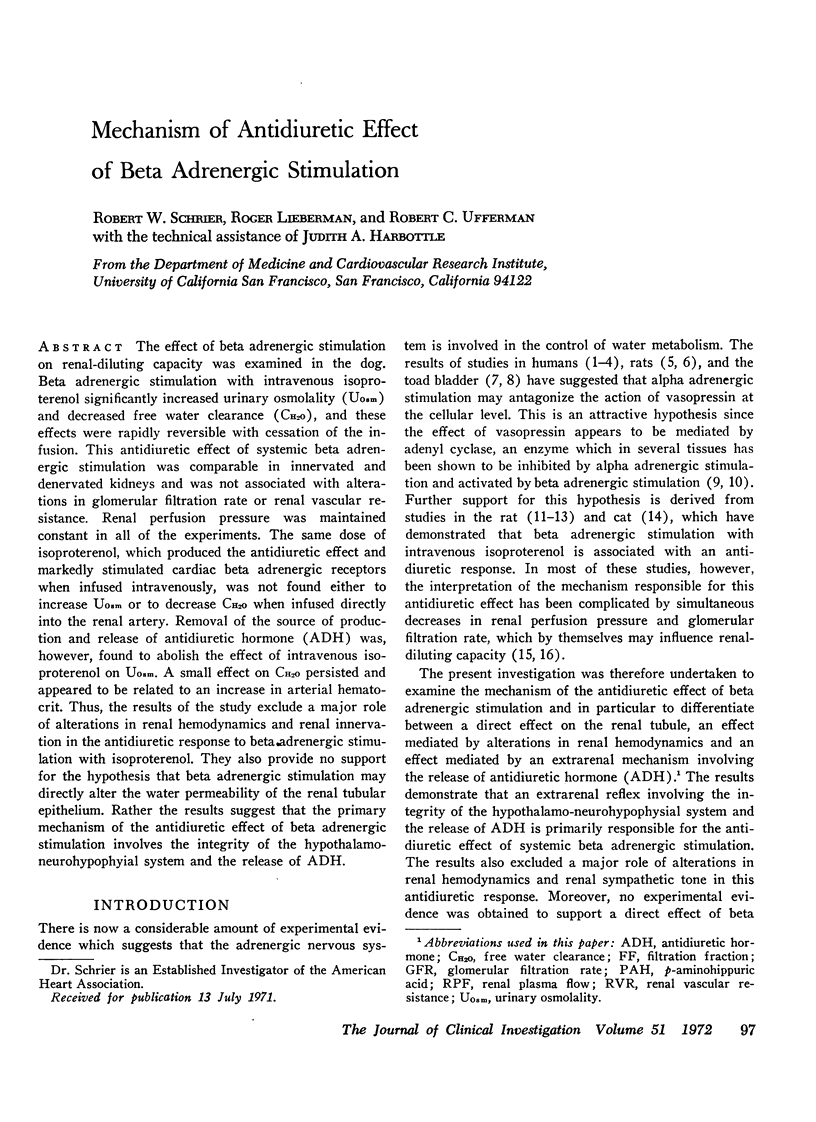
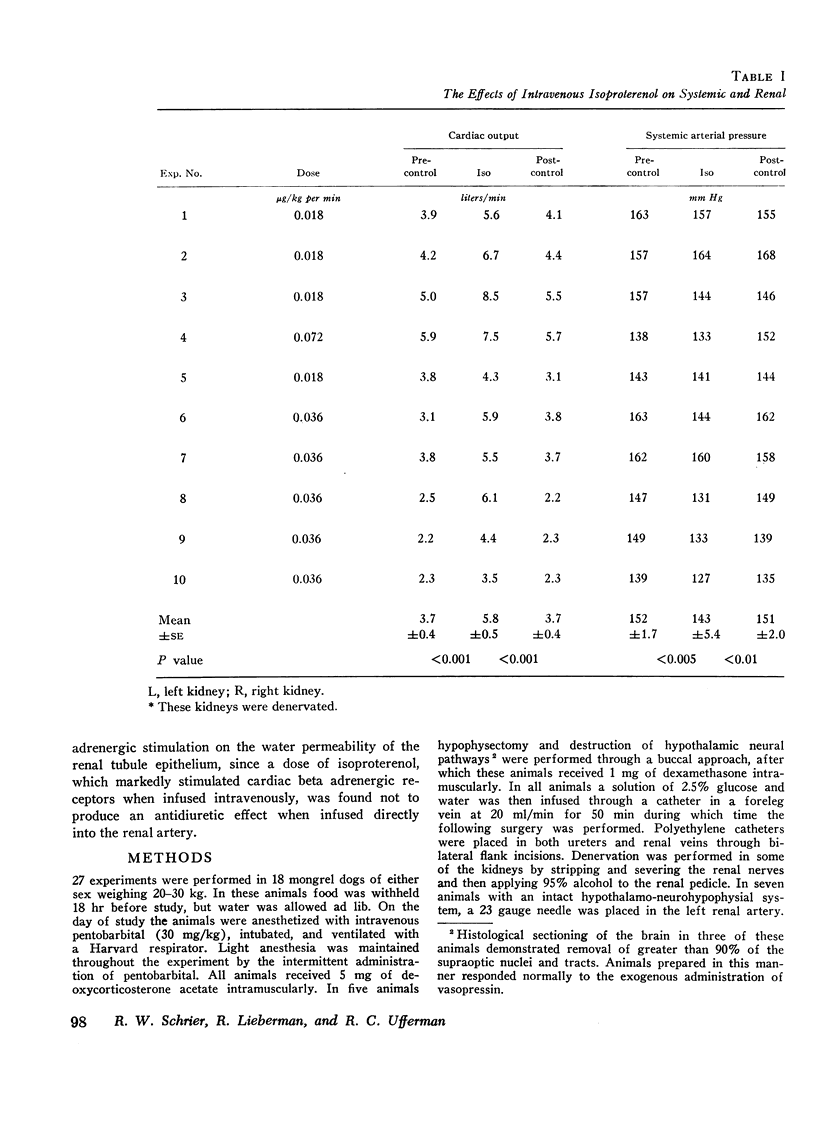
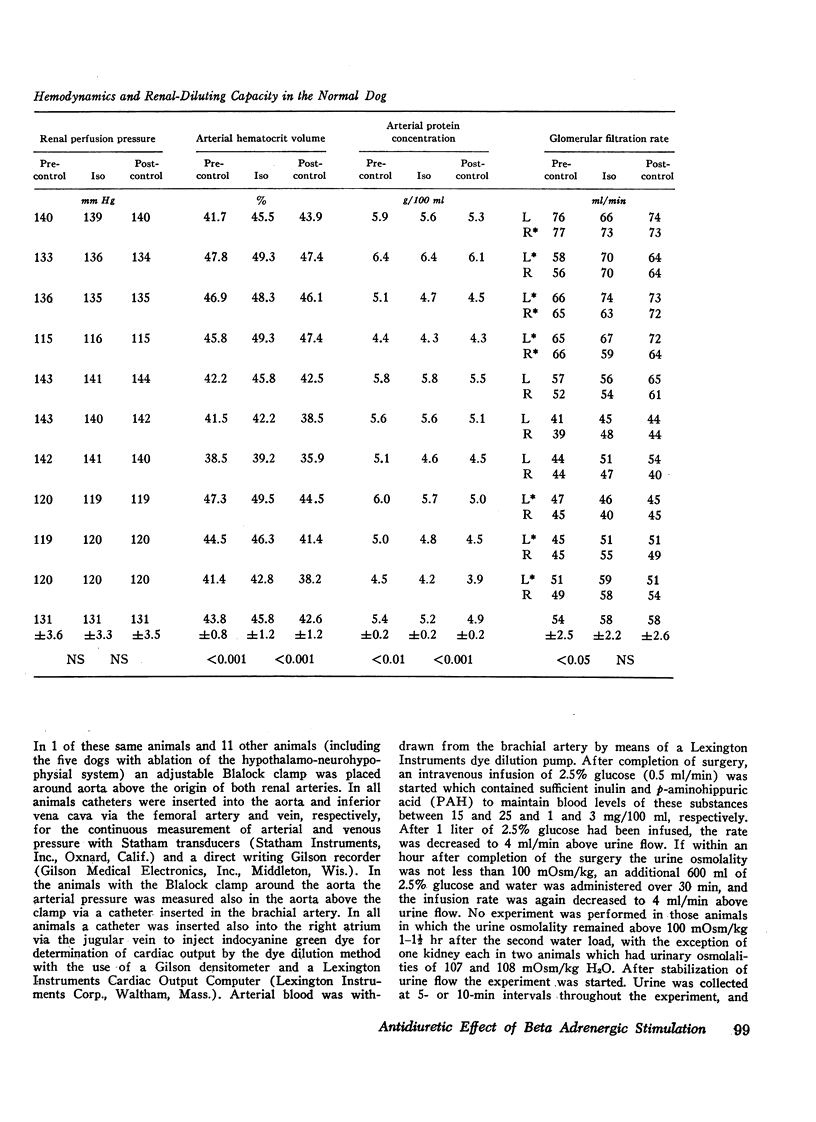
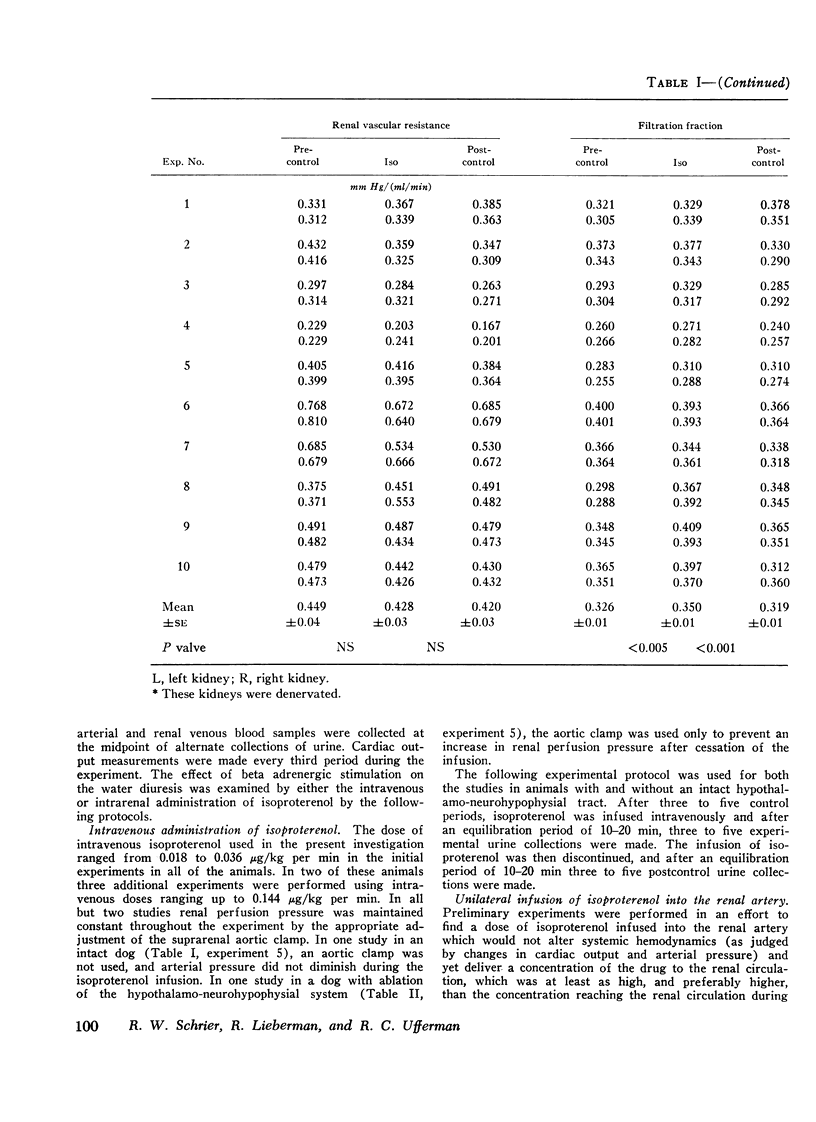
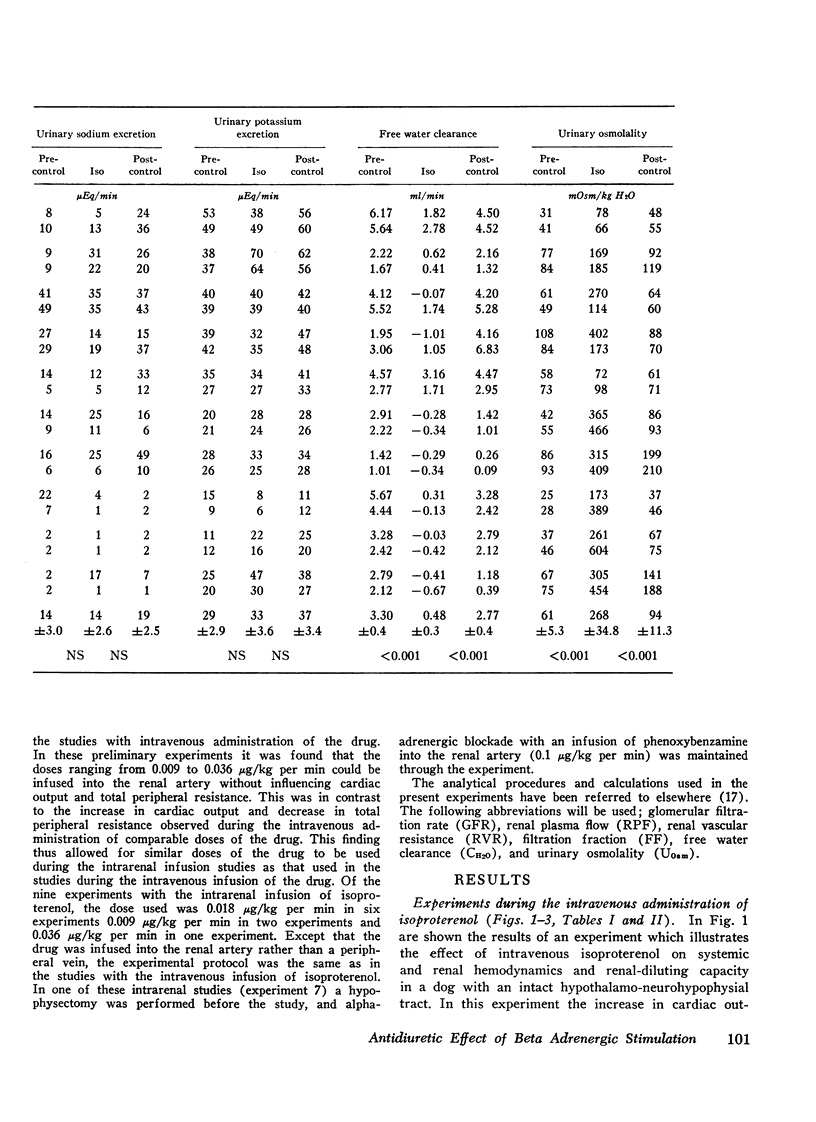
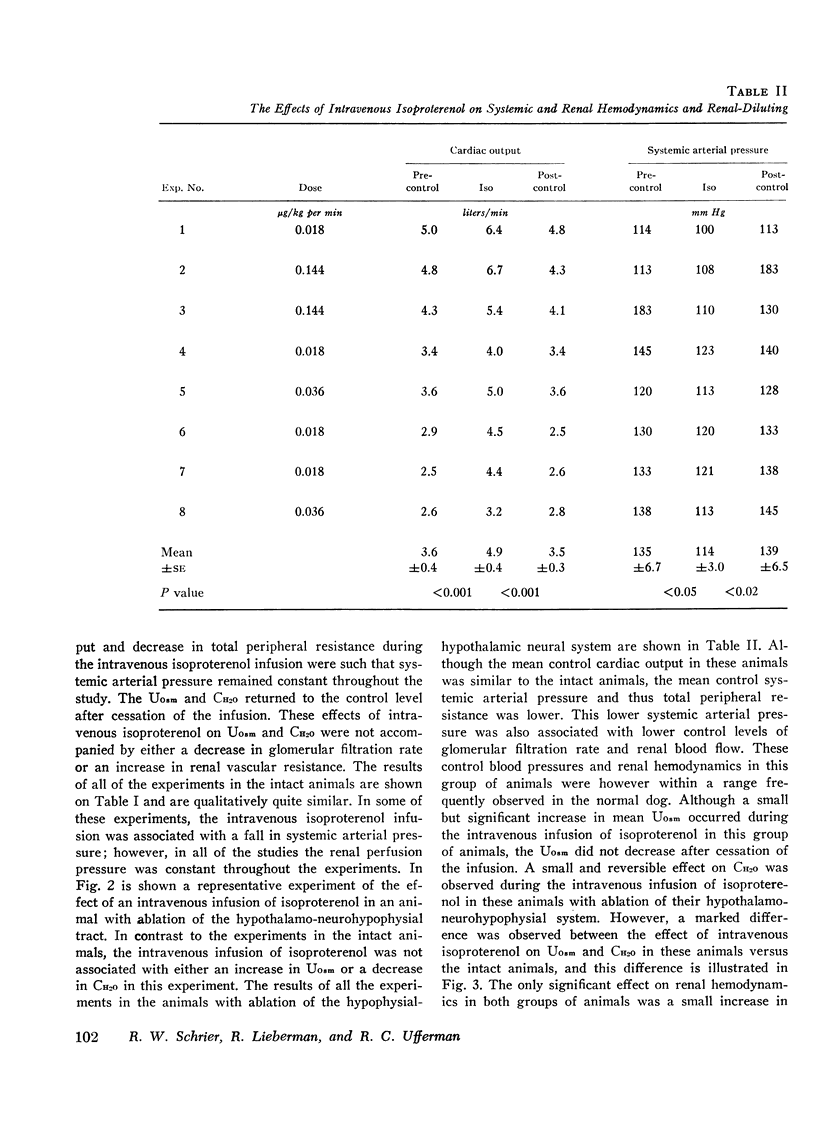
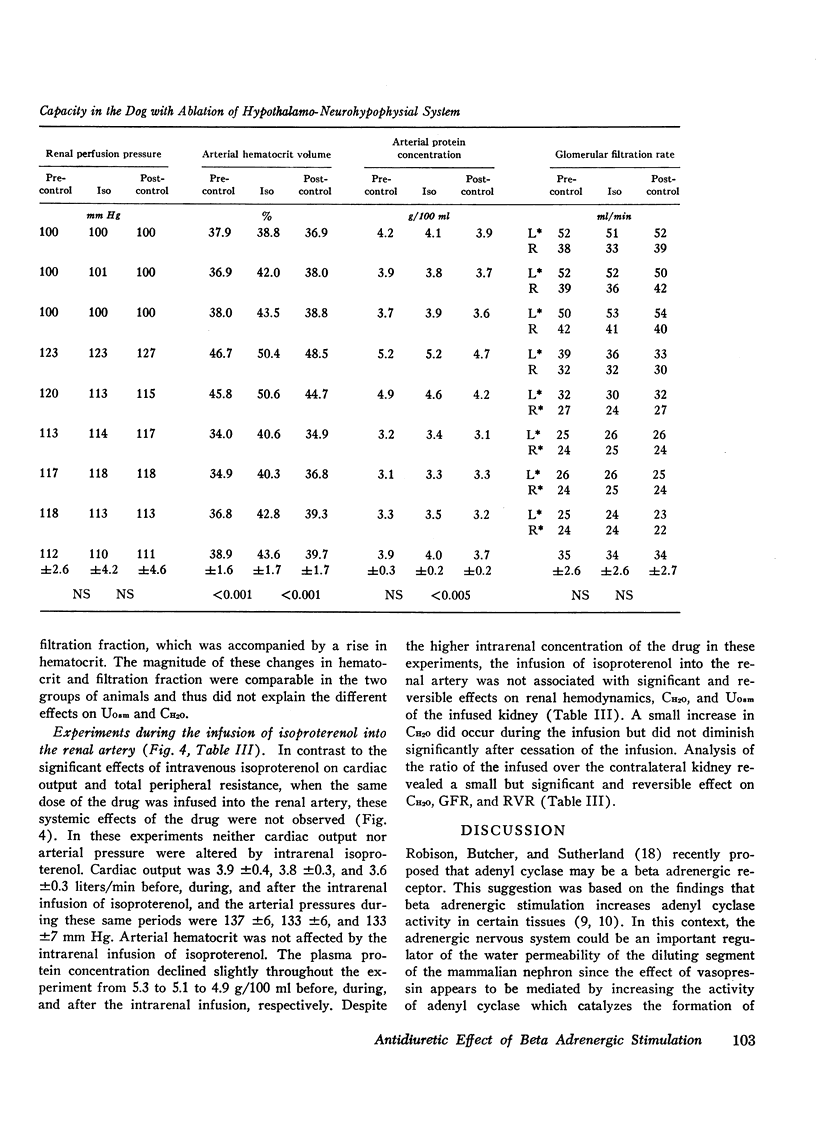
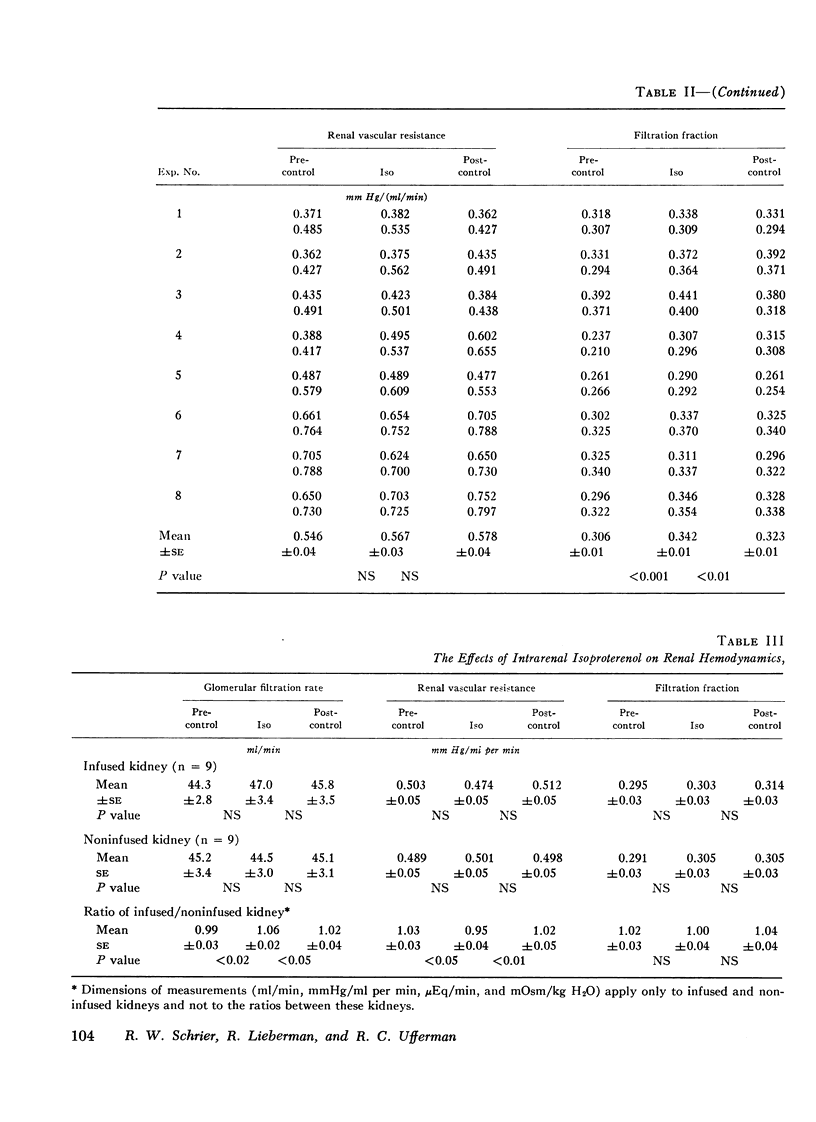
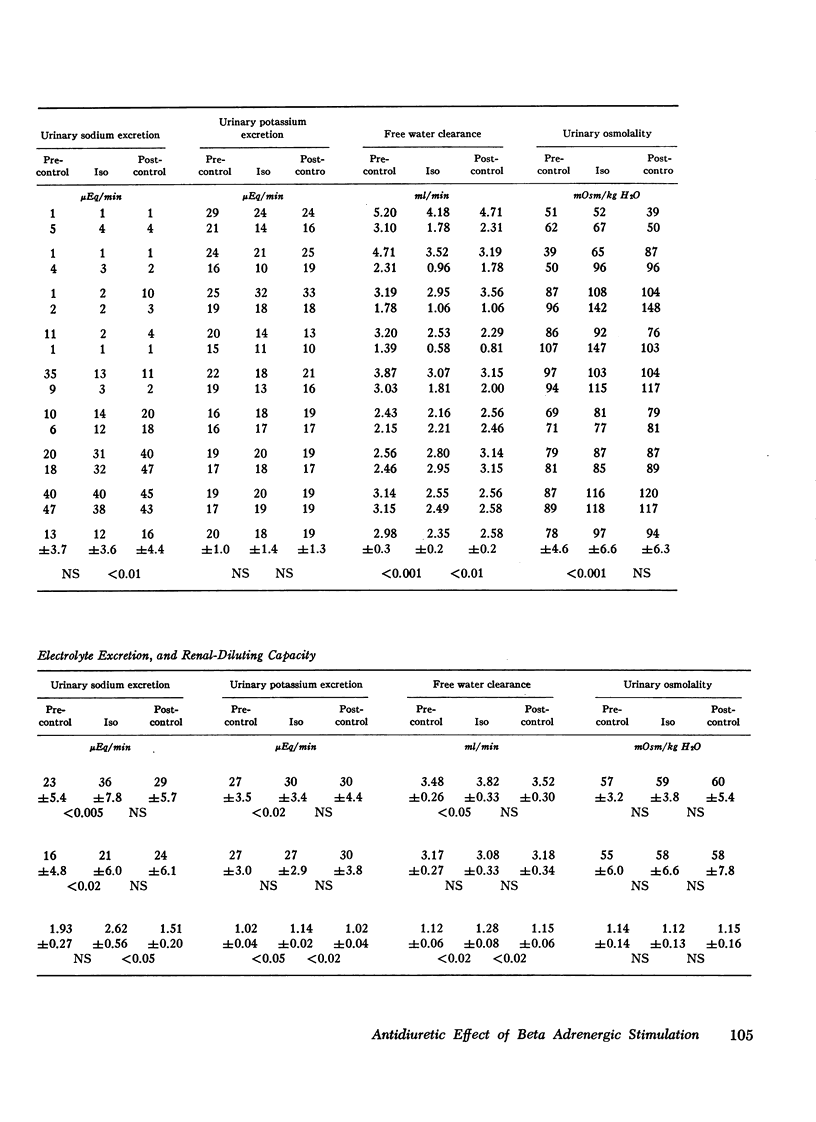
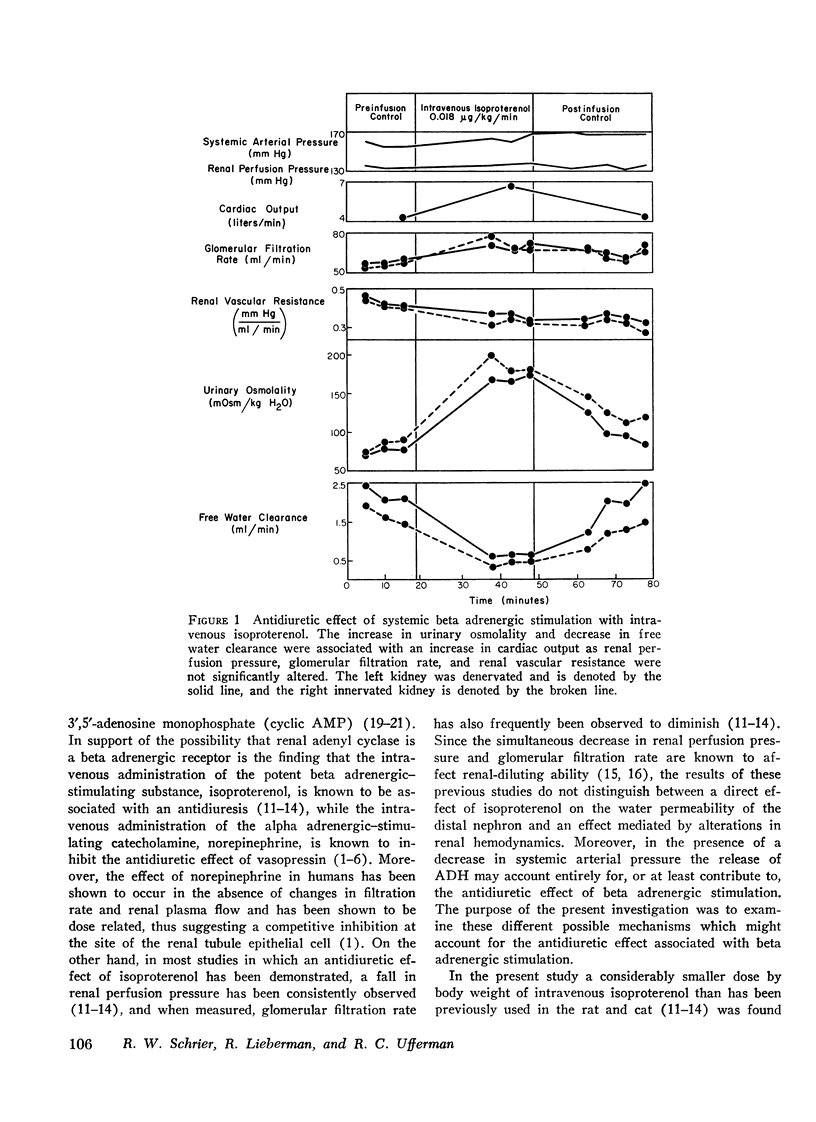
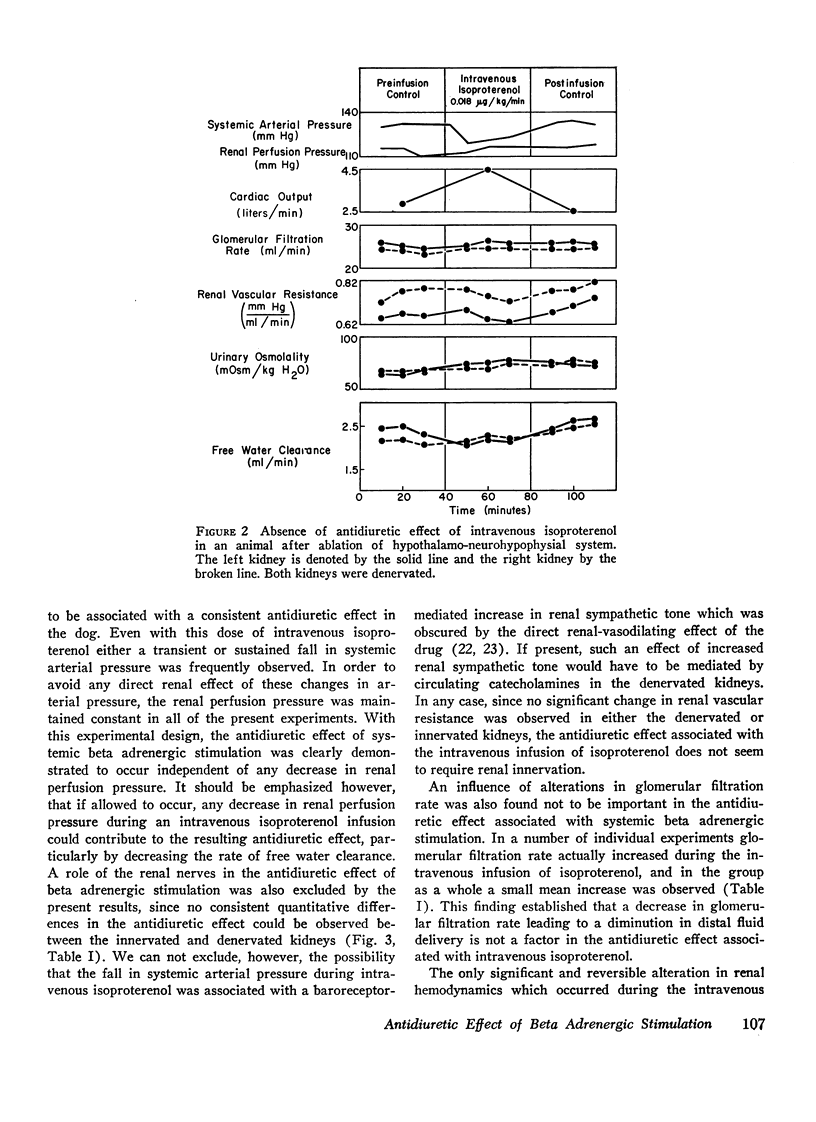
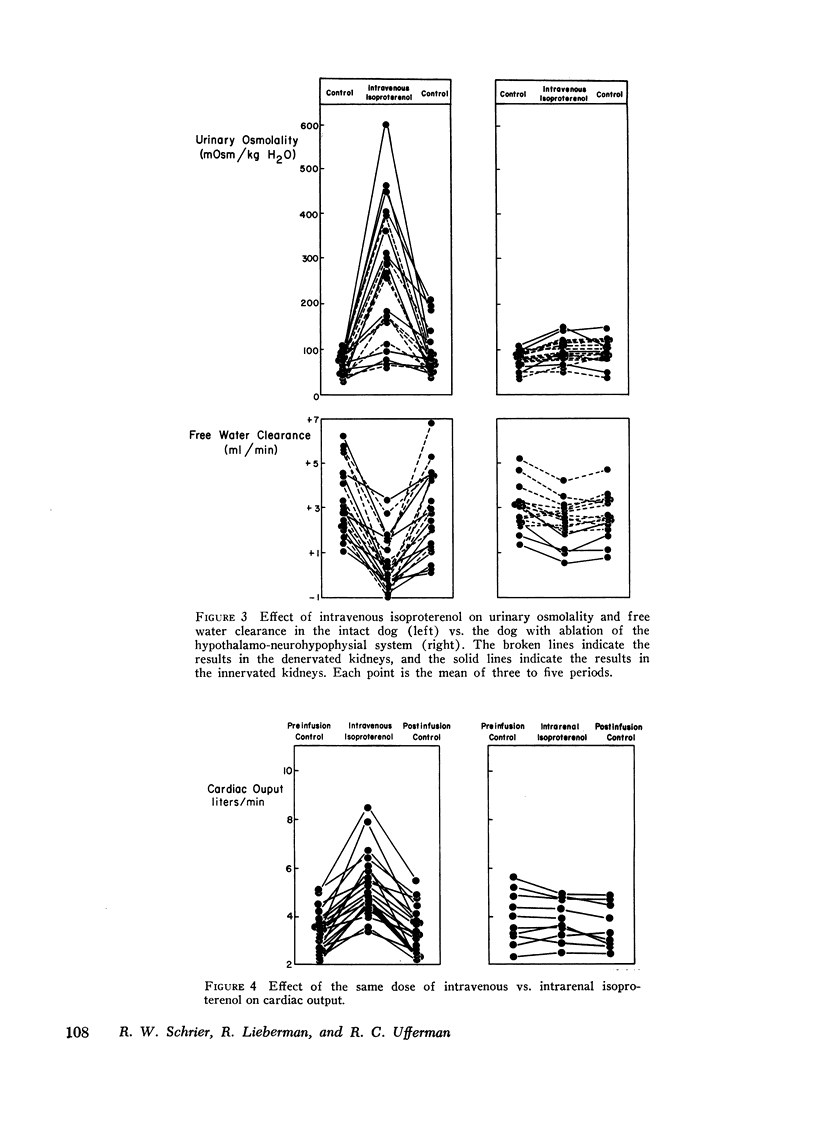
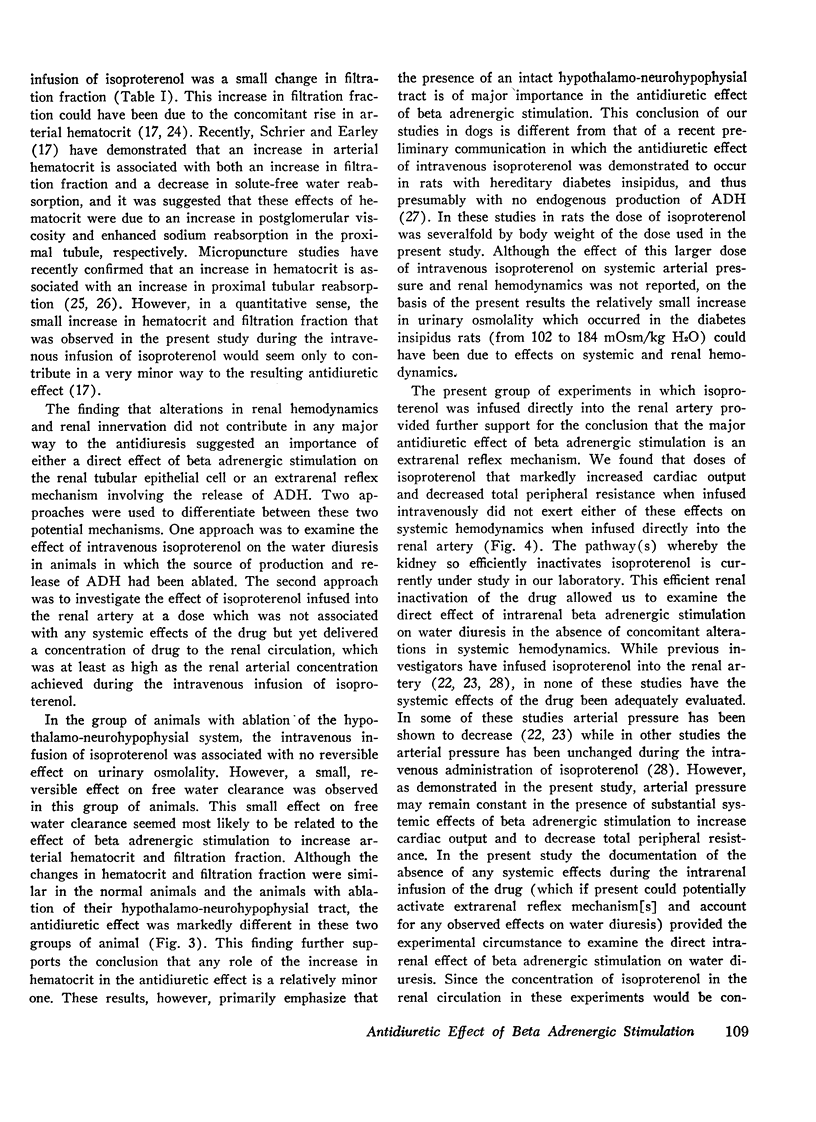
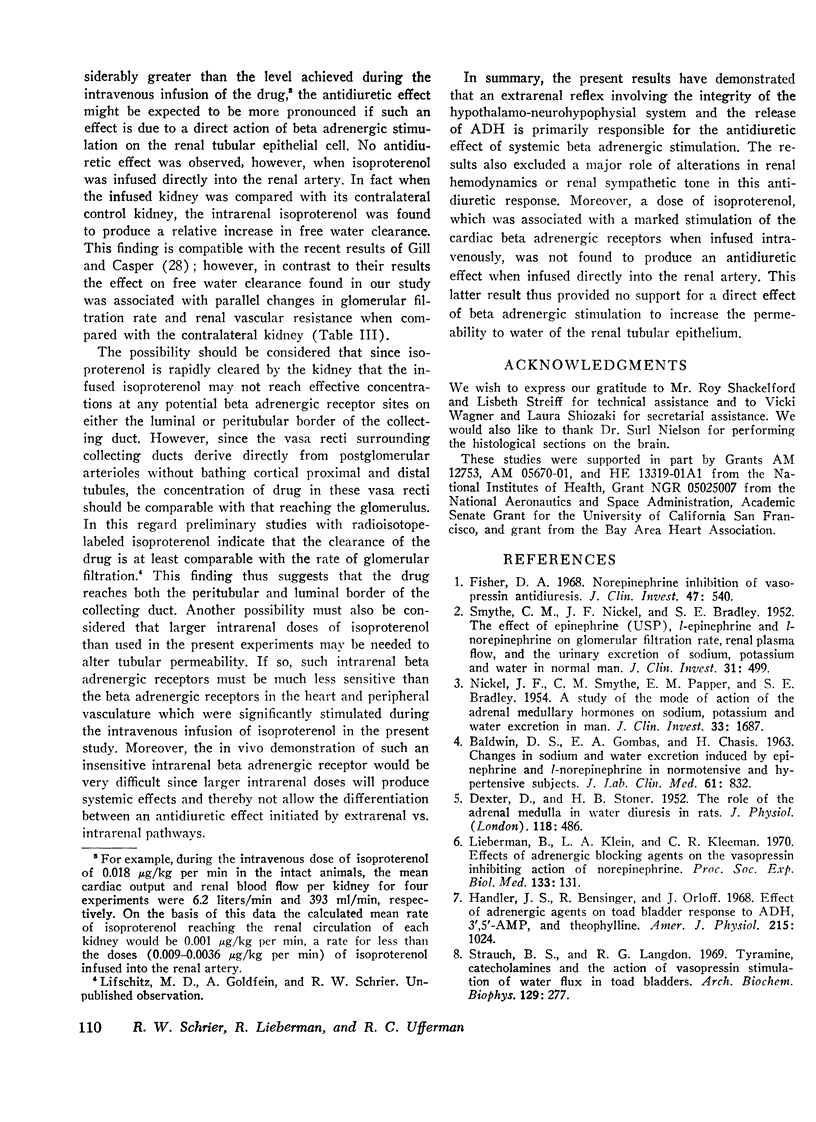
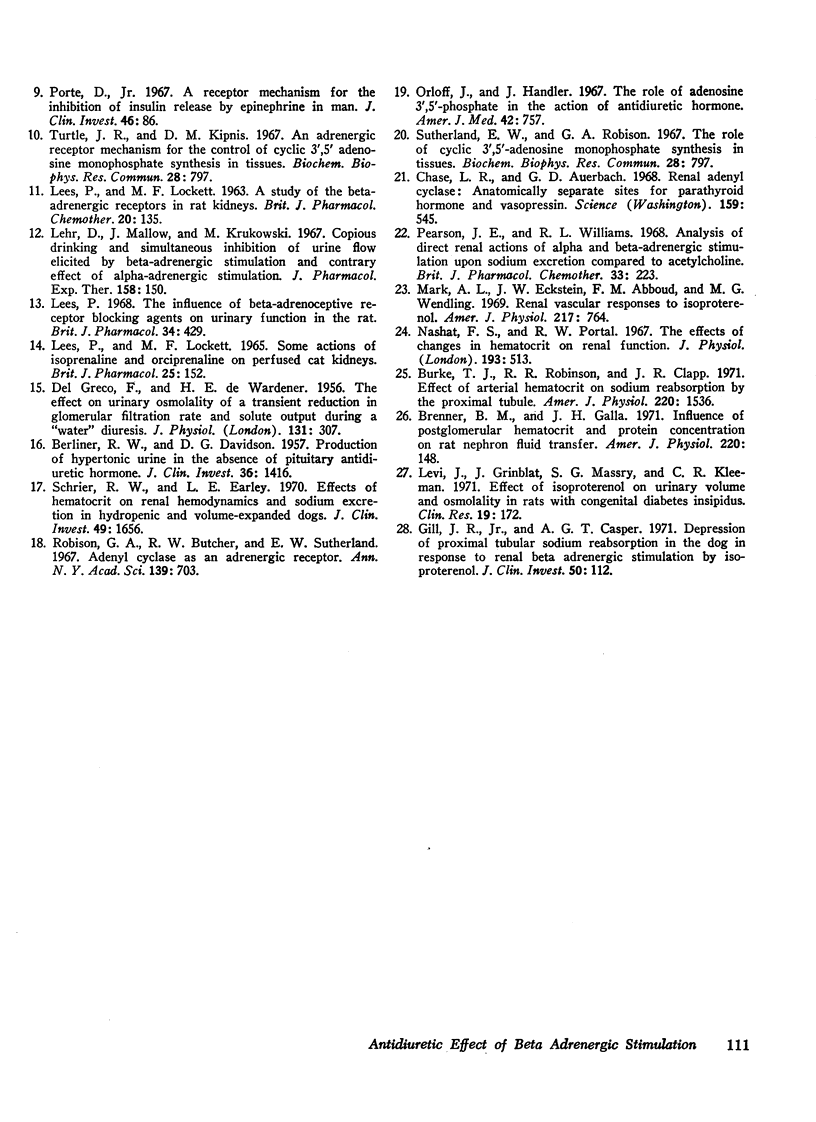
Selected References
These references are in PubMed. This may not be the complete list of references from this article.
- BALDWIN D. S., GOMBOS E. A., CHASIS H. Changes in sodium and water excretion induced by epinephrine and I-norepinephrine in normotensive and hypertensive subjects. J Lab Clin Med. 1963 May;61:832–857. [PubMed] [Google Scholar]
- BERLINER R. W., DAVIDSON D. G. Production of hypertonic urine in the absence of pituitary antidiuretic hormone. J Clin Invest. 1957 Oct;36(10):1416–1427. doi: 10.1172/JCI103541. [DOI] [PMC free article] [PubMed] [Google Scholar]
- Brenner B. M., Galla J. H. Influence of postglomerular hematocrit and protein concentration on rat nephron fluid transfer. Am J Physiol. 1971 Jan;220(1):148–161. doi: 10.1152/ajplegacy.1971.220.1.148. [DOI] [PubMed] [Google Scholar]
- Burke T. J., Robinson R. R., Clapp J. R. Effect of arterial hematocrit on sodium reabsorption by the proximal tubule. Am J Physiol. 1971 May;220(5):1536–1541. doi: 10.1152/ajplegacy.1971.220.5.1536. [DOI] [PubMed] [Google Scholar]
- Chase L. R., Aurbach G. D. Renal adenyl cyclase: anatomically separate sites for parathyroid hormone and vasopressin. Science. 1968 Feb 2;159(3814):545–547. doi: 10.1126/science.159.3814.545. [DOI] [PubMed] [Google Scholar]
- DEL GRECO F., DE WARDENER H. E. The effect on urine osmolarity of a transient reduction in glomerular filtration rate and solute output during a water diuresis. J Physiol. 1956 Feb 28;131(2):307–316. doi: 10.1113/jphysiol.1956.sp005464. [DOI] [PMC free article] [PubMed] [Google Scholar]
- DEXTER D., STONER H. B. The role of the adrenal medulla in water diuresis in rats. J Physiol. 1952 Dec;118(4):486–499. doi: 10.1113/jphysiol.1952.sp004810. [DOI] [PMC free article] [PubMed] [Google Scholar]
- Fisher D. A. Norepinephrine inhibition of vasopressin antidiuresis. J Clin Invest. 1968 Mar;47(3):540–547. doi: 10.1172/JCI105750. [DOI] [PMC free article] [PubMed] [Google Scholar]
- Gill J. R., Jr, Casper A. G. Depression of proximal tubular sodium reabsorption in the dog in response to renal beta adrenergic stimulation by isoproterenol. J Clin Invest. 1971 Jan;50(1):112–118. doi: 10.1172/JCI106464. [DOI] [PMC free article] [PubMed] [Google Scholar]
- Handler J. S., Bensinger R., Orloff J. Effect of adrenergic agents on toad bladder response to ADH, 3',5'-AMP, and theophylline. Am J Physiol. 1968 Nov;215(5):1024–1031. doi: 10.1152/ajplegacy.1968.215.5.1024. [DOI] [PubMed] [Google Scholar]
- LEES P., LOCKETT M. F. A study of the beta-adrenergic receptors in rat kidnevs. Br J Pharmacol Chemother. 1963 Feb;20:135–138. doi: 10.1111/j.1476-5381.1963.tb01304.x. [DOI] [PMC free article] [PubMed] [Google Scholar]
- Lees P. The influence of beta-adrenoceptive receptor blocking agents on urinary function in the rat. Br J Pharmacol. 1968 Oct;34(2):429–444. doi: 10.1111/j.1476-5381.1968.tb07063.x. [DOI] [PMC free article] [PubMed] [Google Scholar]
- Lehr D., Mallow J., Krukowski M. Copious drinking and simultaneous inhibition of urine flow elicited by beta-adrenergic stimulation and contrary effect of alpha-adrenergic stimulation. J Pharmacol Exp Ther. 1967 Oct;158(1):150–163. [PubMed] [Google Scholar]
- Liberman B., Klein L. A., Kleeman C. R. Effect of adrenergic blocking agents on the vasopressin inhibiting action of norepinephrine. Proc Soc Exp Biol Med. 1970 Jan;133(1):131–134. doi: 10.3181/00379727-133-34424. [DOI] [PubMed] [Google Scholar]
- Mark A. L., Eckstein J. W., Abboud F. M., Wendling M. G. Renal vascular responses to isoproterenol. Am J Physiol. 1969 Sep;217(3):764–767. doi: 10.1152/ajplegacy.1969.217.3.764. [DOI] [PubMed] [Google Scholar]
- NICKEL J. F., SMYTHE C. M., PAPPER E. M., BRADLEY S. E. A study of the mode of action of the adrenal medullary hormones on sodium, potassium and water excretion in man. J Clin Invest. 1954 Dec;33(12):1687–1699. doi: 10.1172/JCI103049. [DOI] [PMC free article] [PubMed] [Google Scholar]
- Nashat F. S., Portal R. W. The effects of changes in haematocrit on renal function. J Physiol. 1967 Dec;193(3):513–522. doi: 10.1113/jphysiol.1967.sp008375. [DOI] [PMC free article] [PubMed] [Google Scholar]
- Orloff J., Handler J. The role of adenosine 3',5'-phosphate in the action of antidiuretic hormone. Am J Med. 1967 May;42(5):757–768. doi: 10.1016/0002-9343(67)90093-9. [DOI] [PubMed] [Google Scholar]
- Pearson J. E., Williams R. L. Analysis of direct renal actions of alpha and beta adrenergic stimulation upon sodium excretion compared to acetylcholine. Br J Pharmacol Chemother. 1968 Jun;33(2):223–241. doi: 10.1111/j.1476-5381.1968.tb00984.x. [DOI] [PMC free article] [PubMed] [Google Scholar]
- Porte D., Jr A receptor mechanism for the inhibition of insulin release by epinephrine in man. J Clin Invest. 1967 Jan;46(1):86–94. doi: 10.1172/JCI105514. [DOI] [PMC free article] [PubMed] [Google Scholar]
- Robison G. A., Butcher R. W., Sutherland E. W. Adenyl cyclase as an adrenergic receptor. Ann N Y Acad Sci. 1967 Feb 10;139(3):703–723. doi: 10.1111/j.1749-6632.1967.tb41239.x. [DOI] [PubMed] [Google Scholar]
- SMYTHE C. M., NICKEL J. F., BRADLEY S. E. The effect of epinephrine (USP), l-epinephrine, and l-norepinephrine on glomerular filtration rate, renal plasma flow, and the urinary excretion of sodium, potassium, and water in normal man. J Clin Invest. 1952 May;31(5):499–506. doi: 10.1172/JCI102634. [DOI] [PMC free article] [PubMed] [Google Scholar]
- Schrier R. W., Earley L. E. Effects of hematocrit on renal hemodynamics and sodium excretion in hydropenic and volume-expanded dogs. J Clin Invest. 1970 Sep;49(9):1656–1667. doi: 10.1172/JCI106383. [DOI] [PMC free article] [PubMed] [Google Scholar]
- Strauch B. S., Langdon R. G. Tyramine, catecholamines and the action of vasopressin on stimulation of water efflux in toad bladders. Arch Biochem Biophys. 1969 Jan;129(1):277–282. doi: 10.1016/0003-9861(69)90176-3. [DOI] [PubMed] [Google Scholar]
- Turtle J. R., Kipnis D. M. An adrenergic receptor mechanism for the control of cyclic 3'5' adenosine monophosphate synthesis in tissues. Biochem Biophys Res Commun. 1967 Sep 7;28(5):797–802. doi: 10.1016/0006-291x(67)90388-9. [DOI] [PubMed] [Google Scholar]
- Turtle J. R., Kipnis D. M. An adrenergic receptor mechanism for the control of cyclic 3'5' adenosine monophosphate synthesis in tissues. Biochem Biophys Res Commun. 1967 Sep 7;28(5):797–802. doi: 10.1016/0006-291x(67)90388-9. [DOI] [PubMed] [Google Scholar]


